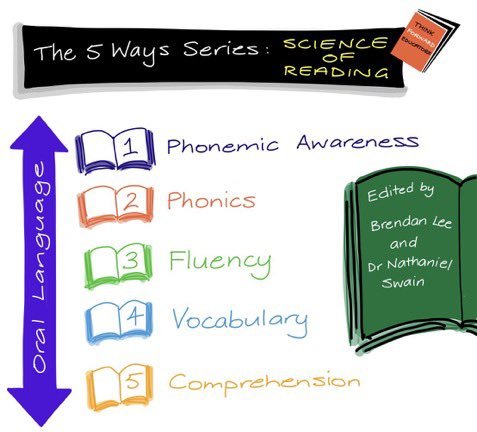5 Ways To: Support Oral Language
Over the coming weeks, Think Forward Educators will be posting a series of blog articles written by educational experts providing ready-to-use tips on how to implement the Science of Reading into the classroom.
Inspired by Tom Sherrington’s Five Ways Collection, the posts have been edited and curated by Brendan Lee and Dr Nathaniel Swain.
The fifth blog post of the series from structured literacy specialist, Kathryn Thorburn gives us a fantastic look at oral language.
Oral Language skills are a critical foundation for literacy and educational success. It is the medium of instruction in all Australian schools and therefore poor oral language skills can impact learning in all subject areas across the curriculum. There is strong evidence that a wide range of language skills including vocabulary knowledge and grammatical skills are critically important for the development of reading comprehension.
Children who enter school with poor language skills are at high risk of educational under achievement. In Australia, 20% of 4-year-olds have language skills below a level expected for their age. In the typically developing student, oral language skills continue to develop throughout the K-12 school years, impacting learning, social/emotional development, and behaviour.
“Early oral language skills are one of the best predictors of later social skills, and difficulties expressing oneself is linked to behaviour problems”
There are multiple aspects to language skills, and they contribute to reading in different ways. Language includes phonology which provides the foundation for code-based aspects of literacy, more broader language skills including vocabulary and grammar contribute to the development of reading comprehension skills and pragmatic language skills are related to one’s ability to use language for interacting with others.
Why is Language important for Mental Health
Early oral narrative language predicts academic achievement [Bishop & Edmondson, 1987], especially reading comprehension in the fourth, seventh and tenth grades [Snow et al, 2007], and writing [Kim et al, 2015] [in Spencer & Pierce, 2022]. Oral language forms a bridge to written language especially for transfer of academic language skills [vocabulary, grammar, syntax and, text structure knowledge]. When students are initially learning their code related word reading skills there is value in working on comprehension without text to minimise cognitive load [Spencer & Pierce, 2022].
Putting it into Practice
Here are five strategies that you can use to support oral language in the classroom.
Build in ways to check understanding and application of what’s been taught
Limit the amount of teacher talk
Use the 10 second rule
Teach students how to recognise what they understand
Provide good models for talk, interaction, and group work.
(1) Build in ways to check understanding and application of what’s been taught
Build in ways to check understanding and application of what’s been taught – ask students to retell and summarise. Do this regularly and not only at the end of the lesson. Use questioning to support retell and summarisation skills e.g., who, what, where, when, how, why, what happened?
Retelling is considered one of the most valid methods of measuring comprehension whether one hears or reads a passage [Read & Vaughn, 2012 in Spencer & Pierce, 2022]. It is a critical skill that integrates both listening for understanding and expressing one’s understanding [Spencer & Pierce, 2022]
(2) Limit the amount of teacher talk
Limit the amount of teacher talk – Reduce the language load and make concepts visual e.g., graphics, diagrams, graphic organizers, or photographs with a focus on patterns and colour coding.
(3) Use the 10 second rule
Use the 10 second rule - allow plenty of thinking time so that the pupil can process what has been said before responding.
(4) Teach students how to recognise what they understand
Teach students how to recognise what they understand and what they don’t understand and give strategies for seeking help or clarification. Encourage an ‘asking friendly’ environment, where children are encouraged to say when they don’t understand or need help.
(5) Provide good models for talk, interaction, and group work
Provide good models for talk, interaction, and group work. Give students specific roles for group work, e.g., encourager, questioner, timekeeper, leader, observer – show them what to do and practice what to say.
References
https://ican.org.uk/i-cans-talking-point/professionals/tct-resources/universally-speaking/
https://acamh.onlinelibrary.wiley.com/doi/abs/10.1111/jcpp.12737
www.speechpathologyaustralia.org.au – Fact Sheet 2
https://ila.onlinelibrary.wiley.com/doi/full/10.1002/trtr.2144
https://ila.onlinelibrary.wiley.com/doi/full/10.1002/trtr.2108
Infographic by Dr. Charlotte Forwood, teacher, speech pathologist and occasional sketchnoter.
About Me:
Kathryn Thorburn is a dual qualified Speech Pathologist and Teacher with a Masters in Special Education. She has 25 years experienced as a Speech Pathologist and runs a small private practice, Language and Learning. Kathryn has 20 years experience in education, she is a NESA accredited teacher and has taught in mainstream classroom & school executive roles in NSW Department of Education, and AISNSW schools across K-12.
She has worked in an Education Officer: Developmental Disabilities Role within Catholic education, piloted an Rehabilitation - Education Liaison Role for the Hunter New England Paediatric Brain Injury & Rehabilitation Teams and has more recently been involved in the curriculum reform process with NESA for K-2 & 3-6 English.
Kathryn understands first hand the demands placed on classroom teachers and strives to make the complex practical to support schools to support learners in the most effective, time and resource efficient manner possible.
For more info, check out www.languageandlearning.com.au/





